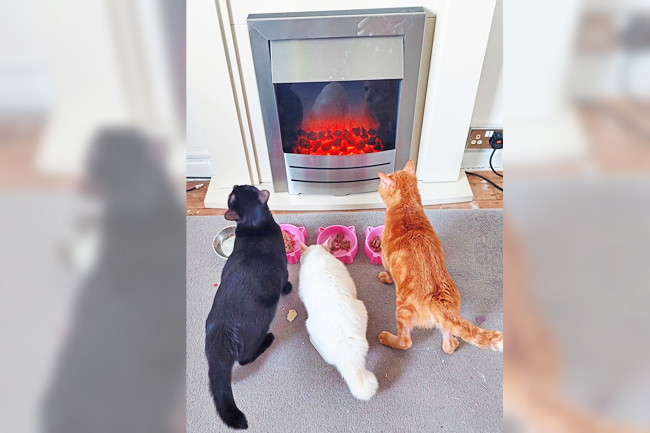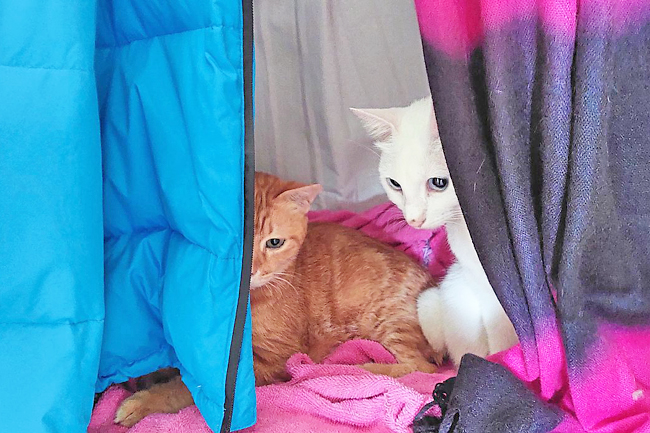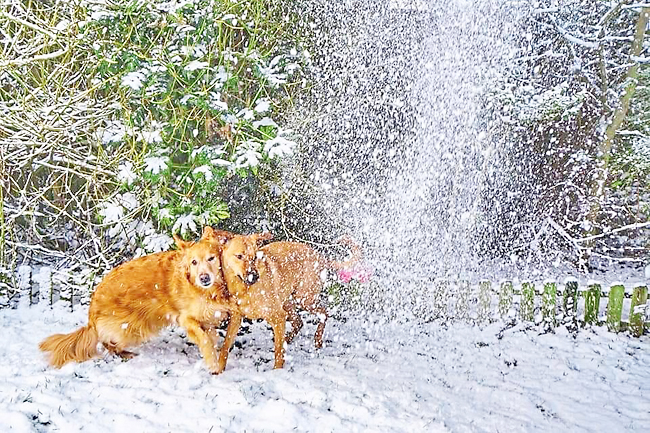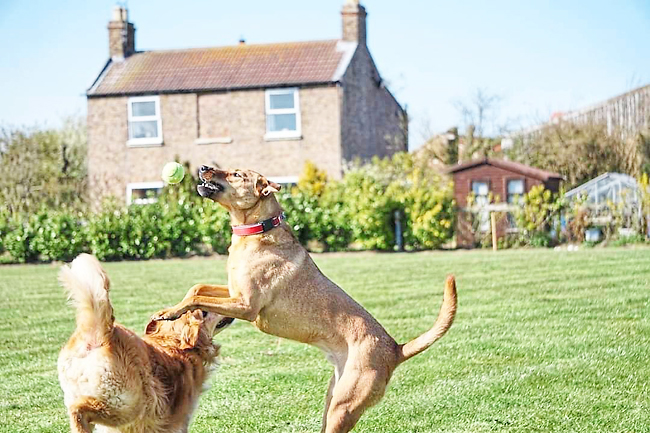ANN/THE STAR – Moving is always a pain – especially when choosing to live in another country entirely. The logistical headaches become even more intense when taking into account larger distances, family members and pets.
For those wrestling with the decision to move, there are many who have completed the journey ready to share their experiences.
LOCKDOWN RELOCATION: BENTLEY AND ROLLS
Cheryl Ellron from Keningau, Sabah, had two dogs to plan around when she was moving to Britain in the middle of the first lockdown in August 2020.
“Rolls and Bentley are both rescue dogs,” Ellron said. “Bentley was born in a rubbish bin. The people in his neighbourhood complained about the stray pups, and so he was in danger of being euthanised. Thankfully, a rescuer picked him and his siblings up.
“Poor Rolls was living rough in the street. He was skinny, covered in ticks, and clearly in trouble. Nobody answered the found ads we placed, so we think he was dumped.”
Bentley is about seven years old now and Rolls probably around nine. They are loved and thoroughly spoilt, and their mum didn’t hesitate when she relocated to Britain.
“We were in and out of the first lockdowns so the paperwork was awful and with flights very hard to book,” Ellron remembered.





“There were all sorts of extra regulations, so I hired an agency. As flights were unpredictable, we also decided to fly direct from Kuala Lumpur to London to avoid any kind of issue halfway.”
As the dogs didn’t associate crates with frightening trips to the vet, Ellron followed the standard advice and let them play in them in the run-up to the move.
“It worked well for them,” she said. “We gave them their blankets and rewarded them with treats for going in and coming out. By the time the flight came, they were quite comfy going in and out, and also sleeping in their crates.”
This was a good thing because the dogs had to travel to and wait in the Kuala Lumpur International Airport (KLIA) pet hotel 24 hours before their flight, a step that meant staff had to put them in and out of their crates. Then, on arrival in Britain, they were uncrated again while waiting at the Heathrow pet hotel.
“I cried my eyes out when the van took them away,” Ellron admitted.
“But when we saw them in Heathrow, the dogs were fine! And they settled in straight away when we took them home.”
The paperwork was stellar, and the logistics of seeing the vets and doing tests in the pandemic was an extra challenge. However, Ellron doesn’t regret it.
“Rolls and Bentley are family. I think we paid about MYR10,000 for their move, and it was worth it,” she laughed.
“They are Malaysian dogs but they’re really enjoying their United Kingdom (UK) life. New food, new surroundings and, best of all, there’s wonderful new experiences like walking in the snow!”
They may have had a rough start in life, but Rolls and Bentley are living the high life.
OLD BOY, NEW TRICKS: TARGET (AND TIC TAC AND INKIE)
When we decided to move from Malaysia to Britain, the first concern was moving our cats, Target, 16, Tic Tac, four, and Inkie, two. Thankfully, the six-month mandatory quarantine in Britain was abolished in 2012. However, the import process was tricky, requiring both paperwork and a set of vet visits.
Relocating cats is simple in one way because they are small enough to fit easily in a crate. However, cats hate change. Also, many cats associate the crate with vet visits, and so the crate itself is a frightening thing.
Because of this, the standard advice that you should crate your cat to get used to it is counterproductive. Putting cats in and out of crates is stressful to them, especially when there are three mandated vet visits, two of which need to be done a week before the flight!
We got our rabies shots and microchips in the middle of the year, and went for Nipah virus checks and the final government vet check 10 days and, again, one day before the flight in November.
Cats look and act tough because they have hearts like mafiosi. They never admit to being scared. But the day before the fight, traumatised by the various vet visits, all the cats were huddled together with big eyes, a sure sign of nerves.
Like Bentley and Rolls, we chose the direct flight to London from KLIA because we wanted to avoid layovers and potential delays in the Middle East. However, a 14-hour flight plus check-in time meant an effective trip of 30 hours.
Even worse, Britain forbids cats to fly in the cabin and they aren’t allowed to share a crate either. We knew the cats would hate to be separated, they’re a tight-knit crew, and we were particularly worried about Target who is 16 years old – in his mid-70s in terms of human years.
With two vets assuring us that his health was fine, we sought extra advice from several experts and decided on one tweak.
Originally, we planned to have the cats on our own flight. However, when you arrive on the other side, the UK vets need to do a health check and complete a bit of paperwork.
If you are on the same flight, the cats stay in the crate. But if they arrive the flight before, they get to come out of the crate and share a run at the pet hotel. They can stay 24 hours and it’s free.
The advice given to us was that the opportunity to come out and stretch, and maybe eat too and use the hotel litter tray, would benefit the cats immensely. This was especially so for ours, as we had to follow the flight with a four-hour car trip to our new home.
So we sent them off the night before, isolated in their own crates with their favourite wet food pouches taped on top. Like Ellron, I cried my eyes out. I was half-convinced I was sending them all to their deaths.
The next 30 hours were hell. I had no idea how they were and my imagination ran wild in very nasty ways.
On arrival, the pet taxi was late. My insides were tossing and turning. Arriving at the pet hotel, a few hundred metres from Heathrow,
The receptionist looked at the paperwork, smiled and said, “They didn’t eat but they had a drink of water. I’ll just go get them for you.”
I’m not the type to hug but it occurred to me she was behind two-inch-thick plexiglass to prevent relieved pet guardians ruthlessly hugging and crying all over her.
When the crates came out, in the freezing early dawn, all three cats were quiet and sitting as far back as they could. Their soiled towels went straight into the bin. Thankfully, the staff had lined their carriers with clean shredded newspaper.
There wasn’t a movement or sound, but as we piled the crates into the warm pet taxi and they heard my voice, they started to talk. Tic Tac meeped like a kitten, demanding reassurance, and Inkie rasped a protest.
I climbed into the car, turned around and peered into Target’s crate. My old boy shuddered in relief, sighed, and stretched out.
The transition was brutal – it’s not easy moving from the tropics to cold England, but the cats are adapting.
Our old boy Target eats in front of the fire and has his own snooze space in a warm nest in the cupboard. His transition will take some weeks. But Tic Tac and Inkie are happily running around. Also, as there are lots of dogs here, they spend hours glued to the windows.
Overall, moving the family was a success. Relocating the cats cost just over MYR5,500 per cat, including health checks, chipping, crates and flights. The pet taxi at the end was another MYR5,000. Total, ballpark MYR22,000.
CABIN FLIGHTS, FERRY TRIPS: NICO
When Catherine Wong, a business development manager from Kuala Lumpur, decided to relocate to Brighton, in England, this year, she examined all the different routes and decided that Nico, her two-year-old ginger tabby, would fly with her in the cabin.
Interestingly, it is not airlines that decide whether pets can fly alongside their owners – it is the government of the country you are flying to who mandate this. Although Britain is known to love animals, they don’t allow pets to fly in the cabin on inbound flights.
“I didn’t want Nico travelling cargo,” Wong said. “As I wasn’t in a hurry, I had two other options: Fly into Amsterdam or Paris and then take a train and ferry to the UK.”
Surprisingly, the extra paperwork wasn’t too bad. Nico did not need an European Union passport as he was a transiting kitty. Wong had to complete two extra sets of forms, a cross border to Netherlands (precautionary) and another for Britain.
“I used an agent for the red tape and for telling us when to chip, vaccinate and so on,” Wong shared. “It was well worth it.”
So in August, Nico got to sit in his carrier underneath the seat in front of Wong, and then the two of them travelled by rail and ferry – a trip that took two and a bit days.
Most cats do not like being around strangers, but Nico is a special kitty.
“Nico is used to being out and about, so he isn’t worried about being on his leash with people in the train station or at being surrounded on the ferry,” Wong explained, “I reckoned therefore that being with me on a longer trip was less stressful for him flying a shorter way as cargo by himself.”
On the day, the KLM flight to Amsterdam was full.
“It was cramped,” Wong remembered. “But when we got off, I put him on the leash so he could stretch. We had a walk in the station and then he slept in his bag while I was in the restaurant.”
Sadly, Wong wasn’t able to get a pet-friendly cabin on the ferry.
“They gave Nico a kennel in his own space and there was a dog travelling in the other room, so they weren’t alone,” she shared. “He slept all night and, in the morning, we took a train, which he always likes.”
Wong reckons it cost roughly MYR3,000 to relocate Nico, a sum that is slightly cheaper than cargo.
Like the dogs and cats who also made the move, Nico had started life as a street kitty, rescued by a student who passed him to Wong when he was about six months old.
Today, the adventurous tom is living in a Brighton flat.
“He likes the cold weather!” Wong laughed. “But he needs a garden because he’s an outdoor boy. He can see the community cats from the window and he wants to go out.”
It’s tough to find pet-friendly rentals, so finding one is the challenge, but Wong is undaunted.
“We have swapped numbers with neighbours because we’re all pet-friendly. It won’t be long before Nico gets his freedom back.” – Ellen Whyte






